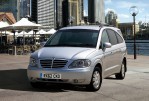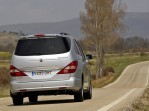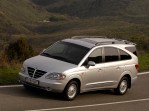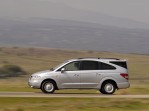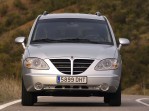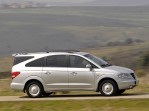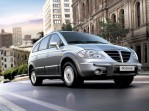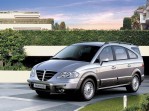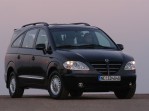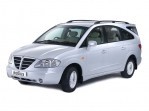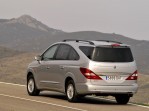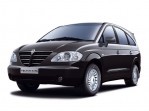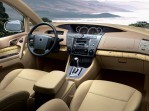Body style: Van
Segment: Large MPV
Production years: 2004, 2005, 2006, 2007, 2008, 2009, 2010, 2011, 2012, 2013
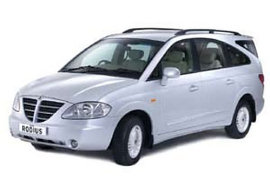 28 Photos
28 PhotosWhen SsangYong started to build its brand awareness worldwide, it didn't consider that it needed a good car designer, and the Rodius was the living proof.
There are two main guidelines in designing a product: forms follow function or function follows forms. The Rodius took the former, but with a slight twist: shape didn't matter as long as it followed the role. Other than that, it was a unique concept of an MPV with an all-wheel-drive system and room for up to eleven passengers inside.
It is hard to believe that Ken Greenley, a respectable professor who ran the transportation design school at the London's College of Art, was responsible for the car's design. The long, curved lines, big headlights, and rounded hood were not so pleasant-looking, to say at least. On the sides, an arched line combined the A-pillars, the roof-line, and the D-pillars. But he realized that the car needs a different ending and installed an additional area behind, like a backpack. The tailgate was huge and crossed by various lines and shapes to make it look smaller.
Inside, the Rodius was a different story. It featured a wide dash-board with the instrument cluster installed in the middle. Its wide speedometer could have been read even by the passengers from the third row of seats. SsangYong offered a choice of a bench for three or a pair of captain seats in the middle. It was a comfortable vehicle with plenty of legroom and headroom for seven adults.
The drivetrain was different than anything on the market. While it wasn't the only AWD MPV, it was the only one that relied on the rear-wheel-drive system, and it automatically transferred torque to the front axle when the road conditions required it. SsangYong took the engines from Mercedes-Benz.
SSANGYONG Rodius 2004, 2005, 2006, 2007, 2008, 2009, 2010, 2011, 2012, 2013
- 2.7L Xdi 5MT (165 HP)
SSANGYONG Rodius
2.7L Xdi 5MT (165 HP)
ENGINE SPECS - 2.7L Xdi 5MT (165 HP) | |
|---|---|
| Cylinders: | L5 |
| Displacement: | 2696 cm3 |
| Power: | 121 KW @ 4000 RPM 165 HP @ 4000 RPM 162 BHP @ 4000 RPM |
| Torque: | 252 lb-ft @ 1800-3250 RPM 342 Nm @ 1800-3250 RPM |
| Fuel System: | Direct Injection |
| Fuel: | Diesel |
PERFORMANCE SPECS | |
|---|---|
| Top Speed: | 105 mph (169 km/h) |
| Acceleration 0-62 Mph (0-100 kph): | 13.5 s |
TRANSMISSION SPECS | |
|---|---|
| Drive Type: | Rear Wheel Drive |
| Gearbox: | 5-Speed manual |
BRAKES SPECS | |
|---|---|
| Front: | Ventilated Discs |
| Rear: | Ventilated Discs |
TIRES SPECS | |
|---|---|
| Tire Size: | 225/65R16 |
DIMENSIONS | |
|---|---|
| Length: | 201.8 in (5126 mm) |
| Width: | 75.4 in (1915 mm) |
| Height: | 71.7 in (1821 mm) |
| Front/rear Track: | 62.6/62.2 in (1,590/1,580 mm) |
| Wheelbase: | 118.1 in (3000 mm) |
| Ground Clearance: | 7.2 in (183 mm) |
| Cargo Volume: | 30.9 cuFT (875 L) |
WEIGHT SPECS | |
|---|---|
| Unladen Weight: | 4425 lbs (2007 kg) |
| Gross Weight Limit: | 6063 lbs (2750 kg) |
FUEL ECONOMY (NEDC) | |
|---|---|
| City: | 21.4 mpg US (11 L/100Km) |
| Highway: | 32.7 mpg US (7.2 L/100Km) |
| Combined: | 27.4 mpg US (8.6 L/100Km) |
| CO2 Emissions: | 230 g/km |







